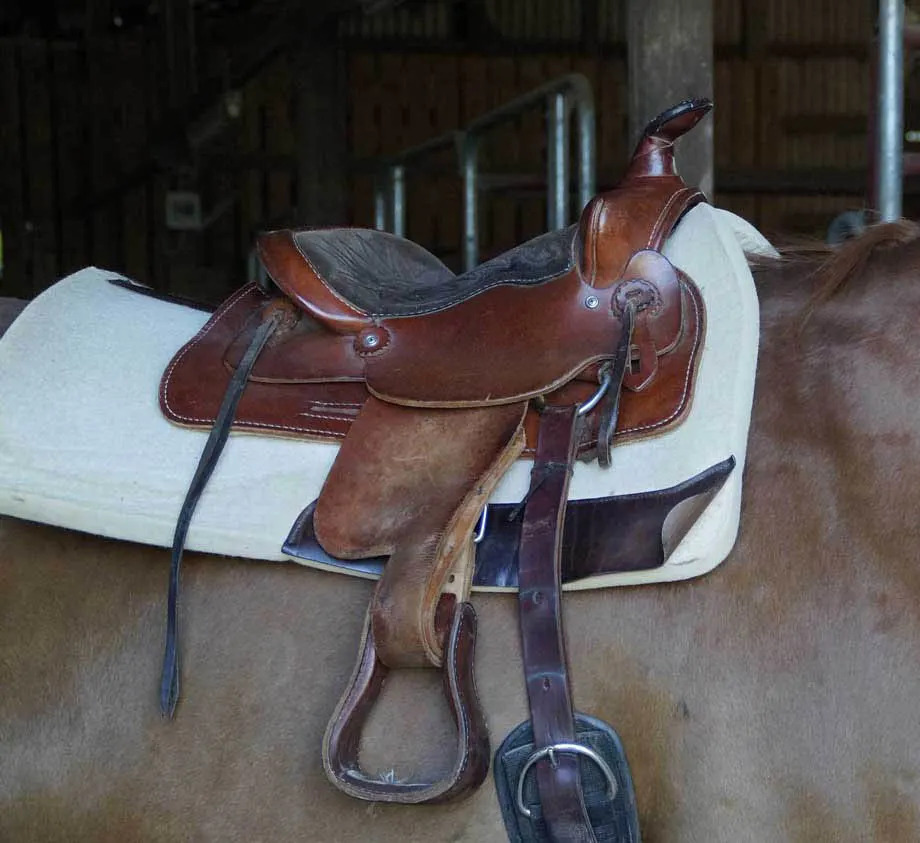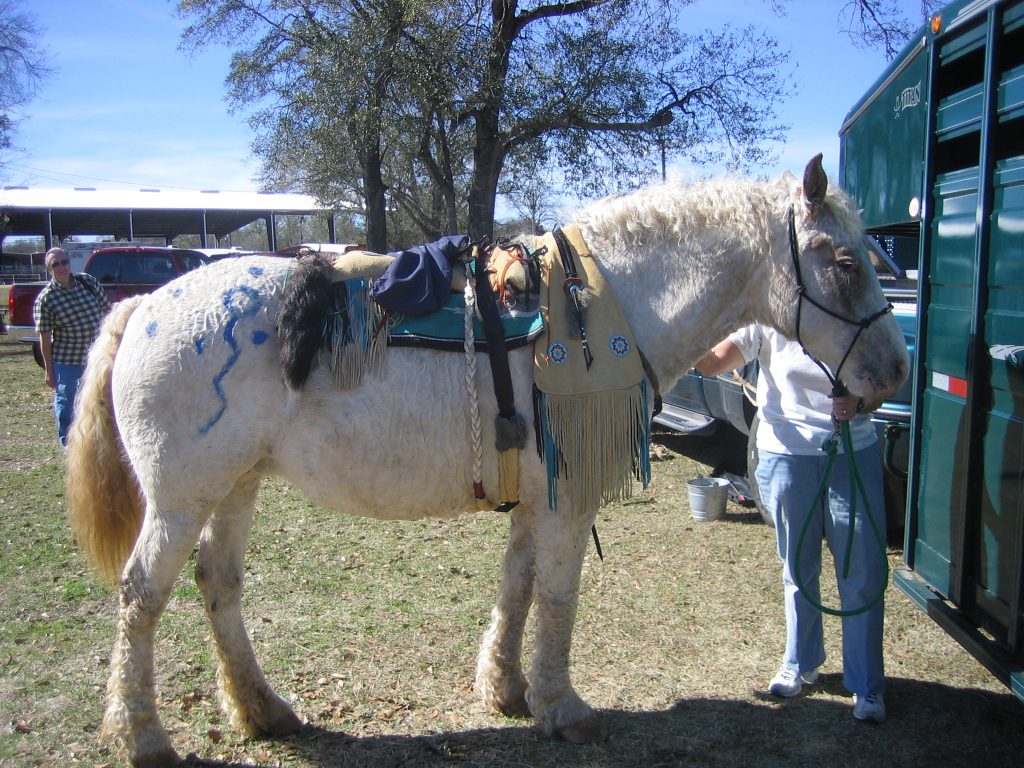New riders often wonder about the difference between English vs. Western riding 🐎. The difference between these two styles of horseback riding can be summarized in three ways:
- Saddle and Bridle Style:
- Western riding uses thick saddles with multiple layers that keep a rider comfortable during long hours in the saddle. A saddle horn is prominent along with a high seat- these help a rider stay seated if a horse moves unexpectedly.
- English riding uses a much smaller, thinner saddle with metal stirrups. This lower profile saddle allows riders to move into 2-point position to jump horses without interference. English bridles generally have more straps than Western bridles.
- Riding Clothing:
- 🎩 English riders wear snug-fitting pants called breeches or jodpurs and knee-high boots or calf protectors. In horses shows, english riders wear blazers and helmets that look like old fashioned hunt caps.
- 🤠 Western riders typically opt to ride in jeans and cowboy boots. Riders often wear highly decorated shirts and pants in shows and rodeos. Traditionally, many riders wear cowboy hats for sun protection although helmet use is increasingly encouraged.
- How Riders Communicate with their Horse: advanced horseback riders often communicate with horses very similarly regardless of the style of riding they do. These riders ride primarily with their body- using their weight, pelvis, and legs to direct their horse. As an observer, though, what you’ll see looks different in English vs Western riding:
- Western Riders hold reins in one hand and “neck rein” their horse. Western horses are often trained to turn away from the pressure of a rein on a neck. Because Western riders use stronger bits, called curb bits, good Western riders avoid any tension in the reins.
- English Riders hold their reins in two hands. Because gentler bits, like full cheek snaffles, are used, riders maintain gentle tension in the reins.
- Words and Jargon: Both Western and English riding communities use words that are specific to their community. Because of this, often, things in the horse world have two correct names!
| English Term | Western Equivalent |
|---|---|
| Bridle | Headstall |
| Girth | Cinch |
| Canter | Lope |
| Trot | Jog |
| Schooling | Training |
| Standing Martingale | Tie down |
| chestnut (brown horse color) | sorrel |

A Limited View
Western and English are usually seen by Americans and Europeans as the only riding styles. However, there are dozens or hundreds of riding styles around the world!
It’s easy to understand how these riding styles became known as the only two options – they were the riding styles popular in two of the most powerful nations in the 19th and 20th centuries. You might be surprised to learn, however, that there are almost countless “styles” of horseback riding, each with it’s own techniques, equipment, and aesthetics.
In this article, I will quickly summarize the important elements of these two primary riding styles in the United States, and then we’ll talk a little bit about some of the many diverse riding styles around the globe. You’ll learn how you can explore these types of riding from wherever you are.
But first, let’s summarize English vs Western riding in a simple chart:
| English Riding | Western Riding |
|---|---|
| 🏇 Smaller saddle with metal stirrups | 🌵 Intricately tooled saddle with a big seat & straps |
| 👑 Complex bridle with many straps | 🤠 Simple bridle |
| 👖 Snug-fitting pants, helmet, boots | 👢 Cowboy boots with jeans 👖 |
| 🏋️ Saddles weigh about 15-20 lbs | 🏋️ Saddles weigh about 30-40 lbs |
| 🥇 Includes jumping & Olympic sports | 🥇 Includes rodeo and speed events. |
English vs Western Riding
When it comes to riding horses for pleasure, there’s actually not a lot of difference between English and Western riding.
English Riding

Saddle – In the English style of riding, a smaller saddle is used, and the rider’s feet are placed in metal stirrups suspended from a thin strap.
Bridle – On the horses head, a bridle is worn that is very similar to a Western headstall, but unlike the western headstall, the English bridle is more complex – usually including a nose band – aka a “cavesson”- as part of the bridle, as well as a browband at the “forehead”, and a strap securing around the horse’s throat.
Rider – The thin straps which secure the metal stirrups to the saddle sometimes cause chafing, so English riding has a particular wardrobe to remedy this problem. Even casual riders often wear snug-fitting pants with thick leather or synthetic panels along the inside of the knee to protect the skin, as well as knee-high boots (sometimes substituted with a leather or synthetic guard called a half-chap)
When riding in shows, an English rider often wears a special jacket or blazer over a dress shirt called a “rat catcher.” For casual riding or a riding lesson, a smart fitting T-shirt, polo shirt, or athletic top is appropriate. For more on what to wear in riding lessons, check out our guide to what to wear horseback riding.
Western Riding

Saddle – the saddle is the most recognizable element of Western riding. Unlike an English saddle, Western saddles often include intricate tooling, stamping, or engraving in the leather.
Western saddles traditionally have many layers and straps – it’s helpful to understand these additions if we compare it to the difference between a bookbag vs trekking backpacking. The Western saddle was designed for similar purposes – to be comfortable for both horse and rider through many hours of riding. A western saddle needed to have enough straps to secure a rider’s equipment when riding out on open range.
Bridle – Western bridles range from incredibly simple to extremely complex, and often matching the style of the saddle. Western bridles can range from a simple strap that clips to the bit and is held in place by a simple loop around an ear to complex silver-embossed parade bridles.
Rider – Western saddles have large stirrups straps – called fenders – that protect the rider’s leg from chafing and make tall boots unnecessary. Instead, the rider typically wears cowboy boots (or any good boot that supports the ankle and has a heel to prevent the foot from slipping through the stirrup). In shows and rodeos, Western riders often have highly decorated shirts and pants, but for casual riding or a riding lesson, you’ll be most comfortable in jeans or leggings and a casual top.
Why the Differences in Riding Styles Matter
The difference in riding styles doesn’t matter very much until you enter horse shows. The difference between the styles becomes more prominent as you advance from local 4-H club or saddle club shows to elite and very competitive horse shows.
At the higher end of competitions, English and Western riding are very very different.
At high levels of competition, each of these both English and Western riding styles break down into many sub-categories that are each highly specialized.
For example, while both barrel racing and Western pleasure may be offered in the same Western horse show, the dress of the rider, equipment or tack used, and method of riding will be very different.
Similarly, an English horse show might have classes in Hunter-style jumping and show jumping. Even though both are English jumping classes, they are judged very differently (timed versus “style”). Because of that, there will be significant differences in equipment, presentation, and style of riding.
Thinking beyond “English” and “Western”
It can be easy to think with a lens that only sees the most popular styles. But there are many distinct types of equipment and styles of riding beyond English vs western.
Below, you can see two examples. The first example is the Argentinian tack on the horse below, shown mid-cattle drive in Patagonia. The second example is the tack of a native-owned horse in Texas, tacked up in the style of a native American tribe.


In the United States, less common styles of riding include:
- Saddle seat (a type of riding that originated in the South that is used with horses that are “gaited” – or have gates other than walk trot and canter),
- Endurance riding (a type of riding that originated around a marathon like long-distance style riding which combines the lightweight equipment of English riding with the comfort of Western riding),
- riding styles of Native American tribes,
- as well as multiple distinct types of tack and riding that belonged to various indigenous peoples of the United States.

Beyond the United States, every people group that has depended upon horses for transportation at some point in their history has developed a unique style for riding their horses. These include Australian riding, the Gauchos of Argentinian and Uruguayan “estancias” (ranches), master-riders of Mongolian nomadic groups, and the famed Bedouin horsemen in the middle east, as well as countless others.
As you begin exploring the style that’s right for you, think beyond the basic categories to how you can help you and your horse build trust, ride with comfort, and have fun in and out of the saddle!


